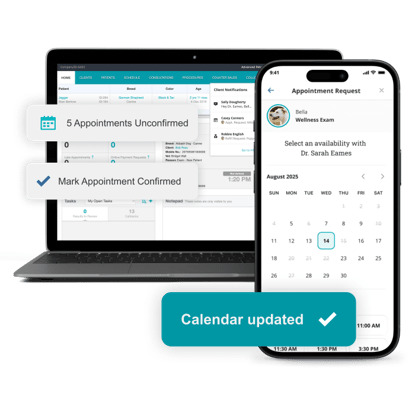Elevate Pet Health: 7 Strategies to Improve Preventive Care Compliance

Veterinary professionals recognize the importance of preventive care in keeping pets healthy. Yet, clients often fail to see the value in routine care, such as regular check-ups, vaccinations, parasite prevention, and dental care. Veterinary teams should communicate effectively to convey the importance of wellness care and encourage a proactive mindset among pet owners. Here are seven strategies to help you reach your preventive care compliance goals.
1. Decide on a consistent message
All team members, from reception to the kennels, should understand preventive care protocols and show support for the hospital’s recommendations. Clients can sense when team members are skeptical of recommendations. Delivering a standard message before, during, and after visits reinforces the importance of routine care and helps pet owners make confident, informed decisions.
Train team members to convey the long-term value of preventive care so pet owners can see beyond the initial investment. Frequent team meetings can keep everyone on the same page and allow time to update or adjust protocols that aren’t working in daily practice.
2. Customize care plans
A one-size-fits-all approach can be off-putting for clients. Tailored care plans based on lifestyle, life stage, and health history reflect each pet’s individuality and help improve preventive care compliance. Clients who view care recommendations as specific to their pet’s needs and receive appropriate education regarding health risks are more likely to agree to services and follow through on long-term plans.
3. Leverage technology
Technology can help clients learn about preventive care and keep them on schedule. Modern practice management software can unburden your team members by sending automated reminders for appointments, vaccinations, and parasite prevention refills to ensure pet owners don’t forget essential tasks. Educational content shared with pet owners via email newsletters, client communication apps, blog posts, and social media platforms can help your clients understand why each recommended service is important, helping to improve overall preventive care compliance.
4. Offer financing solutions
The cost of preventive care can deter clients from scheduling visits, but offering practical solutions can help combat this concern. If you have cloud-based veterinary software, many services can be integrated directly into your clinic’s dashboard for administrative ease. Consider the following options:
- Wellness plans — Annual services bundled into a predictable monthly payment can help spread out costs and simplify recommendations.
- Pet insurance — Pet insurance covers non-routine care, which can free up client funds for preventive care.
- Payment plans — Third-party lenders offer flexible options to help clients pay for preventive or non-routine care costs.
5. Focus on client education
Education is a powerful tool for improving preventive care compliance. To fully commit, clients must understand why preventive care services are important and how they can impact their pet’s long-term well-being. Discussing how preventive care can address early health issues and prevent costly diagnostics or treatments down the road can motivate clients to invest in health now rather than later. Consider building a digital education library and sharing real-life examples of how preventive care improved a patient’s life or health.
6. Provide a convenient and stress-free experience
Many pet owners skip routine veterinary care because they feel the visit is stressful for them or their pets. Adopting stress-mitigating practices can turn appointments into positive experiences for pets and pet owners, making them more likely to return for preventive care visits. Convenience is also critical, as today’s pet owners are busy young professionals. Online scheduling, web-based pharmacy services, and telemedicine provide time-saving options pet owners need and can integrate with cloud-based veterinary practice management software.
7. Spread the word
Engaging with the community through social media and in-person events can position your team as local pet health experts. Clients who feel connected to the practice will see you as a trusted source and be more accepting of preventive care protocols and recommendations. You can also use local events to highlight your preventive care programs and educate the community about their importance.
Improving preventive care compliance requires a multimodal approach. Emphasizing the value and importance of routine care while making it easier, less stressful, and more affordable to visit your practice encourages clients to adopt a proactive approach to their pet’s health. With the right strategies, your revamped preventive care program can produce healthier pets, happier clients, and a thriving practice.




